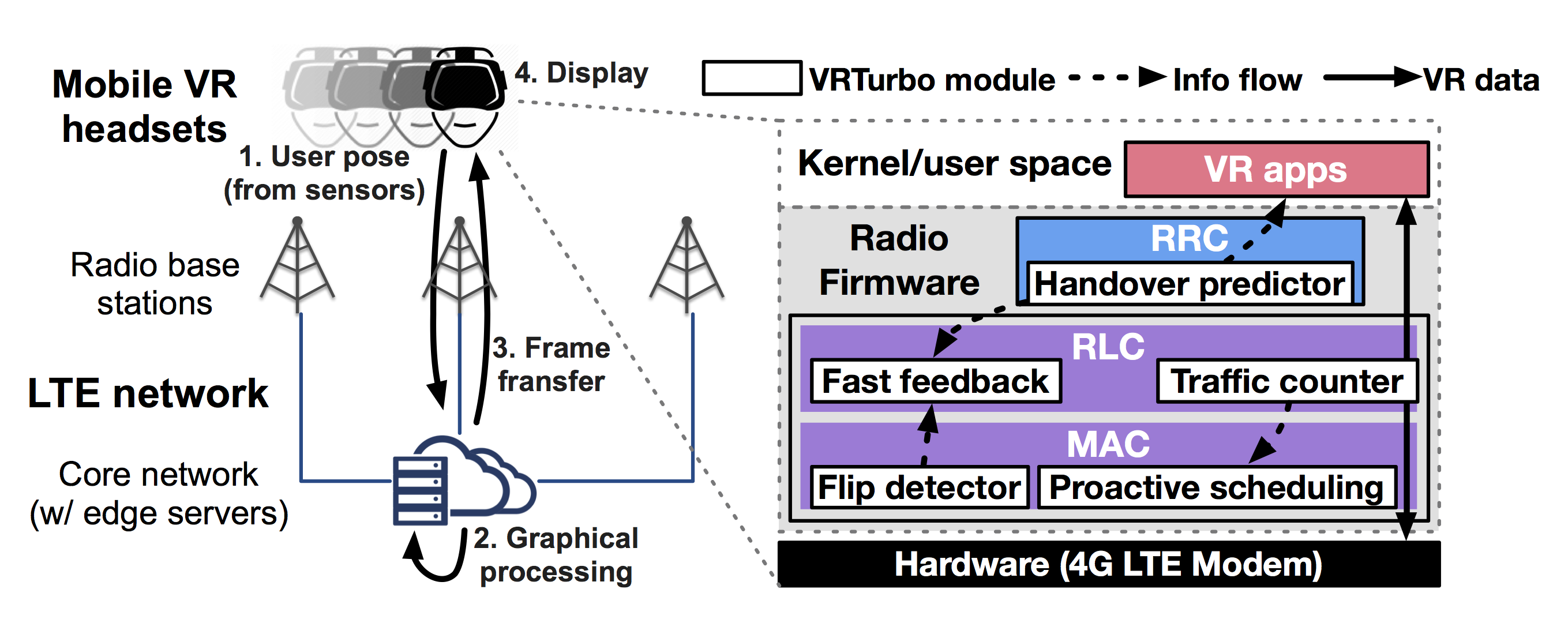Mobile VR/AR
Supporting Mobile Virtual Reality in Cellular Networks

Overview
(1) Problem:
In recent years, we have witnessed a boom in virtual reality (VR). Among all options, the mobile VR empowered by phones (e.g. Google Cardboard) is the most popular. Mobile VR/AR aims to offer users ubiquitous and high-fidelity experiences. We study whether 4G LTE network, which offers large-scale wireless infrasturcture and universal coverage, can support the usage of mobile VR. We focus on what aspects affect the latency of VR under LTE network, and propose solutions to improve the VR user experience in 4G network. We also study how our solution can be extended to 5G applications and other user scenarios
(2) Objective:
In this project, we examine several common perceptions, and study medium-quality mobile VR (say, 60 frames per second and 1080p resolution) over operational LTE networks. We analyze and understand what causes unsatisfactory VR user perception, and propose a new client-side solution that can improve the mobile VR user QoE.
(3) Approach:
We study the standard for latency analysis, then use MobileInsight to collect data for validation and quantification, and finally design our solution to support VR in LTE networks. Our extensive analysis, together with 8-month empirical studies over 4 US mobile carriers, looks into five common beliefs on LTE network latency under both static and mobile scenarios and shows that they are wrong. In fact, they pose as roadblocks to enable mobile VR.
We show that, contrary to common understandings, bandwidth tends to be not the main bottleneck for medium-quality VR. Instead, network latency poses the biggest obstacle for the mobile VR support. Interestingly, a bulk portion of network latency does not stem from wireless data transfer, but comes from the signaling operations used by LTE to facilitate the wireless data delivery. These operations exhibit two categories of latency deficiency: (1) Inter-protocol incoordination, in which problematic interplays between protocols unnecessarily incur delays; (2) Single-protocol overhead, in which each protocol’s signaling actions unavoidably incur delays.
We demonstrate the following:
- During wireless transfer, LTE fails to quickly detect the corrupted VR data, and incurs long latency for error recovery;
- Upon roaming, the headset cannot immediately receive latest VR data after handover; the duplicates incurs head-of-line blocking;
- The uplink channel is latency unfriendly: A new uplink VR packet cannot be delivered immediately after being generate;
- LTE incurs long disruption time during a handover upon roaming.
(4) Outcome:
Following our findings, we devise a solution, called LTE_VR, which is a device-side solution to mobile VR without changing device hardware or LTE infrastructure. LTE-VR adapts the involved signaling operations to be latency friendly, while being 4G standard compliant. In a nutshell, LTE-VR both reactively mitigates the unnecessary latency sources among protocols and proactively masks unavoidable latency inside each protocol.
We have prototyped LTE-VR in a testbed with USRP and OpenAirInterface. Our evaluation shows that, LTE-VR reduces the frequency of graphical frames that miss the human’s tolerance by 3.7X on average. It meets the user’s delay tolerance with 95% probability. It also achieves latency reduction comparable to 10X wireless bandwidth expansion. Furthermore, LTE-VR incurs marginal signaling overhead and extra resource consumption.
Publication
| Supporting Mobile VR in LTE Networks: How Close Are We? ACM SIGMETRICS'18 Zhaowei Tan, Yuanjie Li, Qianru Li, Zhehui Zhang, Zhehan Li, Songwu Lu |
Team Member
- Zhaowei Tan (University of California, Los Angeles)
- Yuanjie Li (University of California, Los Angeles)
- Qianru Li (University of California, Los Angeles)
- Zhehui Zhang (University of California, Los Angeles)
- Sijie Xiong (University of California, Los Angeles)
- Zhehan Li (University of California, Los Angeles)
- Songwu Lu (University of California, Los Angeles)
Dataset
DownloadResearch Support
We gratefully acknowledge research support from the departmental support from UCLA.
